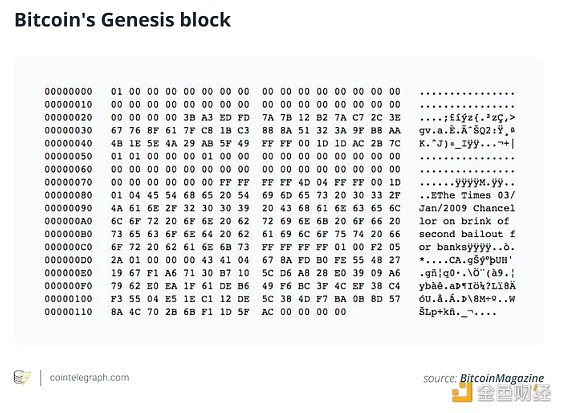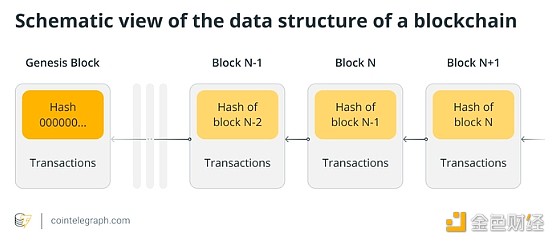Author: Andrey Sergeenkov, CoinTelegraph; Compiler: Deng Tong, Golden Finance
1. Understand the genesis block and its significance
The genesis block establishes a network and abides by consensus rules and start the blockchain by linking all future blocks back to the starting point.
In a Proof of Work (PoW) chain, the genesis block is the first block mined on the blockchain network and serves as the basis for all subsequent blocks. It is usually hardcoded into the protocol and created by the creator of the blockchain. Since there are no previous blocks to reference or mine, it does not involve the traditional mining process.
In contrast, the genesis block is typically created by the network developers and/or validators who launch the PoS chain. Validators can be selected based on specific criteria outlined in the protocol, rather than through a staking process, as there are no previous transactions or stakings to refer to.
The origins of the genesis block can be traced back to the launch of the Bitcoin network in 2009. Bitcoin's pseudonymous creator, Satoshi Nakamoto, generated the first block on the chain, becoming the world's most valuable cryptocurrency by market capitalization, even surpassing the market value of silver at one point. This makes the genesis block an integral part of launching a functional, decentralized blockchain ledger.
The core purpose of the genesis block is to initialize the blockchain by cryptographically linking to the blocks that follow it. It is the starting point for anchoring the blockchain and enabling trust in the immutable ledger. The genesis block sets initial parameters, such as mining difficulty and block rewards, which control the operation and incentive structure of the network. Without the genesis block to provide this foundation, the blockchain would not have a safe and reliable foundation.
All cryptocurrency networks require a genesis block to launch their distributed ledger. For example, Ethereum’s genesis block contains instructions for the initial Ethereum (ETH) allocation and core network parameters.
The genesis block provides a starting point upon which the rest of the growing blockchain can be built. Without a genesis block, a blockchain would have no basis for permanently recording transactions through cryptographic hashes.
2. Bitcoin’s genesis block
Satoshi Nakamoto took the lead in launching the genesis block of the Bitcoin blockchain, establishing the technical attributes that are still used in today’s cryptocurrencies. and distribution model.
The Bitcoin genesis block was mined on January 3, 2009 and is known as Block 0. It was created by Satoshi Nakamoto as a way to launch the network and launch the first cryptocurrency.
Satoshi Nakamoto designed the Bitcoin genesis block to establish the core technical elements of the protocol and set certain launch parameters.
This block contains a reference to the headline "Chancellor on edge of second bank bailout, Times January 3, 2009" published in the London newspaper The Times on 3 January 2009. By including this title, Satoshi timestamped the block and provided a poetic context for Bitcoin’s mission as a decentralized alternative to the traditional financial system.

Genesis Block The specific value of the random number field is 2083236893, which was discovered by Satoshi Nakamoto through the mining process to meet the difficulty target when the Bitcoin network was launched. Although much less difficult than today's standards, creating the genesis block still requires changing the nonce until a valid block hash is found that meets the goal. All subsequent blocks are built on the hash of the genesis block, creating a chain connecting each block to the original block.
One of Satoshi Nakamoto’s most critical decisions was to set the mining reward for adding new blocks to the blockchain. The genesis block includes a coinbase transaction that awards a 50 Bitcoin (BTC) reward, establishing the Bitcoin issuance model. However, this particular reward is a special case and cannot actually be spent due to the unique way the genesis block is hardcoded into the Bitcoin software. The 50 BTC reward sets a precedent for block rewards, which are halved approximately every four years until a total supply cap of 21 million is reached.
The hard-coded design of Bitcoin’s genesis block establishes Bitcoin’s core technical and monetary attributes. As the first block on the Bitcoin blockchain, it launched the network's distributed ledger, laying the foundation for innovation in blockchain technology, cryptocurrency, and finance.
3. Genesis blocks of other cryptocurrencies
Although Bitcoin pioneered the genesis block, other cryptocurrencies have also adopted this mechanism to launch your own blockchain network.
The Ethereum genesis block was mined in 2015 and serves as the basis for the Ethereum blockchain. It establishes the initial supply and distribution of ETH tokens by allocating the Ethereum purchased by early adopters during the presale. However, the genesis block itself does not implement the network’s PoW consensus model, which was a separate part of the Ethereum protocol design (prior to the merger). Ethereum’s approach differs from Bitcoin’s in several ways, most notably the initial token distribution method, which allows early adopters to purchase Ethereum’s native cryptocurrency, ETH, before the network goes live.
Many cryptocurrencies closely copied Bitcoin’s genesis block format when they were launched. Litecoin’s 2011 genesis block is similar to Bitcoin’s, with only minor changes to technical parameters such as the mining algorithm. Dogecoin’s 2013 genesis block pays homage to Bitcoin’s genesis block with coded text referencing newspaper headlines about Bitcoin’s rising value.
Some differences can be seen when comparing cryptocurrency genesis blocks. Some timestamp the proof-of-work with timestamps in the distant past, while others timestamp the most recent genesis block. The initial mining difficulty and block reward amount of the genesis block of different cryptocurrencies also differ.
While similar in structure, each genesis block is unique in the way it initializes the blockchain’s distributed ledger. The blockchain industry continues to innovate on the genesis block structure through alternatives such as proof-of-stake consensus models. However, the genesis block retains an important symbolic role, representing the beginning of a transparent, decentralized financial system.
4. The composition and structure of the genesis block
The genesis block establishes the data and structure format that all future blocks will follow. Laying the foundation for the blockchain.
The genesis block contains the basic data that lays the foundation for the rest of the blockchain. This starting block is hardcoded with index 0 and establishes the structure that subsequent blocks will follow.
The data embedded in the genesis block includes timestamp, block hash, previous block hash, nonce and block reward address. The timestamp represents the creation time of the block, while the hash of the previous block is a series of zeros because no previous block existed.

In projects like Bitcoin In such a PoW blockchain, the nonce is a value that can be changed to find a valid block hash that meets the network's difficulty goal. However, the importance and use of nonces may vary across different blockchain implementations, especially those that do not use PoW consensus. The block reward address indicates where to send the block reward, although this functions differently in the genesis block compared to subsequent blocks.
It is worth noting that the concept of block reward addresses is more subtle in the genesis block, as it does not play a role in the traditional sense in subsequent blocks, especially in blocks like In a network like Bitcoin, the genesis block reward is not spendable.
Additional genesis block events can specify initial conditions or distribute tokens. For example, the smart contract executed by the Ethereum genesis block allocates the starting supply of ETH. It is also not uncommon for genesis blocks to carry encrypted messages or references, adding a symbolic or commemorative layer to the block.
The structure of the genesis block includes a block header and a block body. The header includes metadata such as version, timestamp, target difficulty, Merkle root hash (Rollup transaction) and nonce. The body contains all the transactions in the block, which are just the reward transactions for the creator of the genesis block in the newly launched network.
This standard structure forms a template for the chronological order of subsequent blocks. The fixed composition of the genesis block establishes the blueprint for validating transactions, adding new blocks, reaching consensus, and growing the chain. This groundbreaking first block launched the functionality of the blockchain.
5. Events after the genesis block
The genesis block starts the network. Confirmation, incentives, and difficulty adjustments can then enable decentralized propagation, consensus, and mining to develop the blockchain.
Once the genesis block is established, the blockchain network can be officially launched. This milestone opens up public participation and kicks off the process of consensus and decentralization.
After launch, the blockchain begins to be built on top of the genesis block. As the first block, the genesis block is automatically accepted as valid by network nodes, but it does not require confirmation in the traditional sense like transactions or subsequent blocks. Subsequent blocks reference the hash of the genesis block, establishing an unbroken chain back to the origin of the network.
As the genesis block is confirmed, miners race to add new blocks. As blocks are appended, previous blocks will accumulate more confirmations, thereby strengthening the durability of the blockchain. New cryptocurrencies are issued through block rewards and transactions are verified.
Network difficulty dynamically adjusts based on activity to maintain the pace of block creation. More miners and higher participation increase competition and difficulty, while lower activity lowers the difficulty target. This fluctuation ensures that the blockchain self-regulates.
After the genesis block, the blockchain grew organically through decentralized communication, consensus mechanisms, and incentive mining. This activity solidifies the Genesis Block into an immovable anchor. As adoption spreads, transaction volume increases rapidly.
In the case of cryptocurrency blockchains, value increases as trust in the network is established. Tokens gain monetary value based on market supply and demand dynamics. Speculation, trading, and real-world utilities drive investment and participation.
Therefore, with the activation of the network, the genesis block no longer enjoys an honorary status. The launch it enabled gave birth to a thriving ecosystem governed by participants with aligned economic interests in the blockchain incentive structure.
 Weiliang
Weiliang











